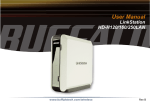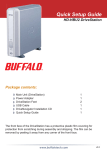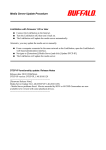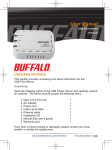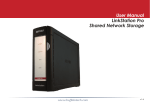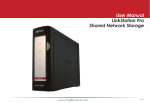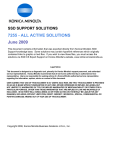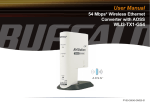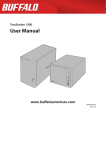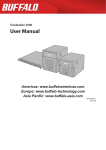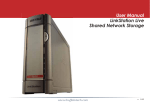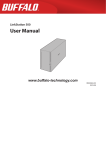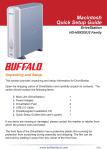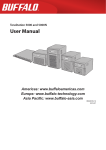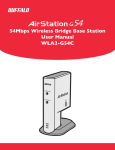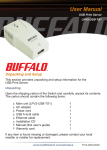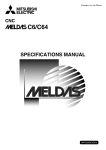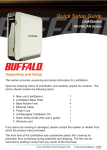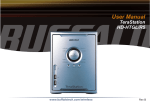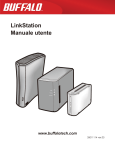Download User Manual
Transcript
User Manual LinkStation HD-H120/160/250LAN PY00-30014-DM20-01 Table of Contents Table of Contents LinkStation Diagram ......................................... 3 LinkStation Quick Setup ................................... 4 LinkNavigator Setup ....................................... 11 Accessing LinkStation Data from PC ............. 20 LinkStation Expansion .................................... 23 Basic Settings ................................................. 24 Network Settings ............................................ 27 Security Settings ............................................ 30 USB Settings ................................................... 37 Maintenance Settings ..................................... 42 Technical Specifications................................. 51 Technical Support ........................................... 52 2 LinkStation Diagram 1. Power Button – The Power Button is used to power the LinkStation on or off. The power on process will take approximately 30 seconds to a full minute to complete. During this time, do not unplug the LinkStation from the wall outlet. To turn the LinkStation off, press and hold the power button for several seconds until the Power LED light begins blinking. At that time, stop pressing the button and shutdown should complete within 30 seconds. 2. Power LED – The Power LED light will blink during startup or shutdown, but otherwise will remain lit up while LinkStation is powered on. 3. LINK/ACT LED – The LINK/ACT LED light will light up if an Ethernet Cable is plugged in that is attached to another device such as a router, hub, or PC. Periodically, the LED will blink. This blinking signifies network activity. 3 LinkStation Diagram 4. Disk Full LED – When LinkStation’s internal drive approaches 98% of its capacity, the Disk Full LED will light up in red. For options to increase storage capacity, see ‘LinkStation Expansion’ section on Page 23. 5. Diagnostic LED – The Diagnostic LED may begin flashing when the LinkStation encounters an error. 6. USB Port (Front & Rear) – LinkStation offers two USB ports for adding external drives or USB printers. Please see the ‘LinkStation Expansion’ section on Page 23 to learn more about how to take advantage of the USB ports on LinkStation. 4 LinkStation Quick Setup The setup of the LinkStation is performed using the following steps: ◗ Plug the LinkStation’s power cord into a power outlet. 5 LinkStation Quick Setup ◗ Press the power button of the LinkStation to turn LinkStation on. Press the power button until the green Power LED turns on. 6 LinkStation Quick Setup ◗ Connect the included Ethernet Cable into the Ethernet port on the rear of LinkStation. Connect the other end of the cable into a hub, switch, or router on the network, or connect it directly to a nearby running PC. 7 LinkStation Quick Setup ◗ Check the LINK/ACT light on the front of the LinkStation. If it is lit, then your LinkStation is connected properly; please turn to Page 11 to continue setup. If it is not lit, continue to the next page. 8 LinkStation Quick Setup ◗ On the rear of the LinkStation, flip the black ‘Cable Selection’ switch. This switch tells LinkStation whether to communicate over a Crossover or Patch cable. ◗ Verify that the LINK/ACT LED on the front of LinkStation is lit (see Page 8’s picture). If it is lit, continue to Page 11 to continue setting up LinkStation. If the LINK/ACT LED is still not lit, please verify the following: 9 LinkStation Quick Setup ✓ Both LinkStation and the switch or PC are powered on. ✓ The Ethernet Cable is securely fastened to both devices. ✓ The Ethernet Cable is not damaged, to verify this try using another Ethernet Cable. ✓ When verifying new cables, remember to switch the ‘Cable Selection’ switch to both positions (see Page 9). 10 Link Navigator Setup The setup of the LinkNavigator is performed using the following steps: ◗ Insert the LinkNavigator CD into a PC’s CD-ROM drive. Depending on the PC’s configuration, the EasySetup program may launch. If it does not automatically launch, manually launch it by pressing the ‘Start’ menu, selecting the ‘Run...’ option. When the ‘Run’ dialog opens, type x: easysetup.exe (where x is the drive letter of the CD-ROM drive). Press ‘OK’ to continue. 11 Link Navigator Setup ◗ LinkNavigator is now running. Please press the ‘Install IP Setup Utility’ icon, then press the ‘Start’ button. The LinkStation IP Configuration Utility will launch and scan for networks. 12 Link Navigator Setup ◗ The IP Configuration Utility allows you to easily configure LinkStation’s network settings. The ‘Search’ button will re-scan the network for any and all LinkStations available. The drop down menu lists all available LinkStations. If there are multiple LinkStations on the network, then select the proper LinkStation from the pull down menu. Once the proper LinkStation has been selected, press the ‘Change IP Address’ button to continue. 13 Link Navigator Setup ◗ This part of the program changes LinkStation’s IP address. Check the check box that states ‘Acquire IP Address Automatically’. This will give LinkStation an IP address from the network’s router/DHCP server. A set (static) IP address and gateway can also be set if preferred. The ‘Administrator Password’ field sets an administrator password for the web-based configuration. If desired, type a password in the field. When finished, press the ‘OK’ button. LinkStation will set the IP address and password settings. 14 Link Navigator Setup ◗ LinkStation is now ready to be configured. The login prompt will appear. The user name is root. There is no password by default. If a password was specified on the previous step, then type that password in, otherwise leave the password field blank. Press the ‘OK’ button when finished. User name: root Password: There is no default password. Only enter a password if one was set on Page 14. ◗ In the future LinkStation can be accessed by typing http://LINKSTATION_NAME into a Web browser (where LINKSTATION_NAME is the name of LinkStation set on Page 17). 15 Link Navigator Setup ◗ Congratulations, you have logged into LinkStation. These are the main configuration menus. Please bookmark this page so it can be accessed for future configuration changes. For detailed explanations of each menu and setting, please refer to the ‘Settings’ section (starting on Page 24) of this manual. To continue setup, click on the ‘Basic’ button. This will allow you to setup some important settings. Then click on ‘LinkStation Name Setup’ link to continue. 16 Link Navigator Setup ◗ This section allows you to change the name of your LinkStation. This name will be required to access LinkStation data. A friendly, easy name is recommended. Please enter an appropriate name in the ‘LinkStation Name’ field. Feel free to use your first or last name, a description of the content to be installed on LinkStation, or simply name it LinkStation. A short description of the LinkStation can be created in the ‘LinkStation Description’ field. Once the fields have been completed, press the ‘Apply’ button. 17 Link Navigator Setup ◗ By default there are two shares on LinkStation. Shares are best described as folders. One is for Windows and Mac machines, while the other is for Macs only. Windows machines will only see one share. If you would like to create additional shares for specific users or specific types of data, then click on the ‘Security’ tab on the left. Then click on the ‘Setup Shared Folder’ link to continue. From this screen you can add new shares/folders or edit existing shares/folders. Press the ‘Add New Folder’ button to begin creating a new share/folder. 18 Link Navigator Setup ◗ To begin setting up a new share, enter an appropriate share/folder name in the ‘Shared Folder Name’ field. Set the remaining settings to the desired function. ‘Access restriction’ will turn on security features. Please refer to the ‘Settings’ section (starting on Page 24) of this manual before using the ‘Access Restriction’ function. Press the ‘Apply’ button when finished. A new shared folder has been setup. Please repeat this step to setup more shared folders. 19 Accessing LinkStation Data from a PC Accessing LinkStation data is performed using the following steps: ◗ Press the ‘Start’ menu, select the ‘Run...’ option. When the ‘Run’ dialog opens, type \\LinkStation_Name (where LinkStation_Name is name of the LinkStation set on Page 17). Press the ‘OK’ button to continue. 20 Accessing LinkStation Data from a PC ◗ LinkStation’s root directory will appear. You will see all of the configured shares. All users can read and write to all folders unless otherwise configured. To setup security and password protection, please refer to the ‘Settings’ section (starting on Page 24) of this manual. To setup a printer see the ‘LinkStation Expansion’ section found on Page 23. LinkStation can be accessed by multiple PC’s simultaneously by following this step. A drive letter can also be mapped for LinkStation, see the next page for more information. 21 Accessing LinkStation Data from a PC ◗ From the previous step’s screen, use the pull down menu and click ‘Tools’ and then select ‘Map Network Drive’. The ‘Map Network Drive’ program will run. Select the drive letter you would like LinkStation to assume from the ‘Drive:’ pull down menu. Type \\LinkStation_Name (where LinkStation_Name is the name of LinkStation set on Page 6) in the ‘Folder:’ field. You can also press the ‘Browse’ button to browse for LinkStation through the network. Once complete, press the ‘Finish’ button. LinkStation is now mapped to a drive letter. 22 LinkStation Expansion LinkStation Expansion Information LinkStation has two USB 2.0 ports on it. These ports can be used for adding an external USB Hard Drive or a USB Printer. LinkStation will then share the USB device to everyone on the network. There is one port on the front of LinkStation and one port on the back of LinkStation. One printer and one external USB Hard Drive can be added to either of the ports. However, two USB Printers or two USB Hard Drives cannot be added, only one of each device. To connect a USB device to LinkStation, simply plug it into one of the USB ports and set it up in the LinkStation configuration. USB Hard Drive Information: See Page 39 to show you how to enable a USB Hard Drive to be used for shared folders. Page 49 will show you how format the USB Hard Drive. Page 46 & Page 47 will show you how to setup LinkStation to backup to a USB Hard Drive. Page 31 & Page 32 will show you how to add more shared folders with a USB Hard Drive. USB Printer Information: See Page 40 to setup a USB Printer on LinkStation. 23 Basic Settings This section explains the functions of LinkStation’s settings: Basic Setup LinkStation Name Setup: LinkStation should be configured with a unique name to identify it over the network. A general description can be given for the device as well. Time Setup: To properly catalogue shares and files by date, and to properly schedule tasks (such as backups), the current date and time must be set. 24 Basic Settings LinkStation Name Setup LinkStation Name: The LinkStation name is a very critical piece of information. This name is used to access LinkStation and is a key element in differentiating LinkStation from other computers and devices on the network. The LinkStation name should be something easy to remember. It can be named after its owner, it’s location, or the type of data that will be installed on it. If there is only one LinkStation on the network, then naming it ‘LinkStation’ would be fine. LinkStation Description: The LinkStation Description is a handy way of differentiating multiple LinkStations. A suitable description would be a short sentence or phrase describing LinkStation’s purpose. The ‘Apply’ button will set the settings. 25 Basic Settings LinkStation Time Setup Time Setup: The LinkStation time must be set to maintain proper logs and to schedule proper backups. Input the proper time and date in or press the ‘Current time is acquired’ button to set LinkStation’s time to the same time as the PC that is being used to configure it. The time may need to be changed at a later time to accommodate any changes of time (e.g. daylight savings). The ‘Apply’ button will set the settings. 26 Network Settings IP Address Setup: By default, LinkStation will attempt to obtain an IP Address from a DHCP Server. If a DHCP Server is not available, it will assign itself an IP Address of 192.168.11.150. Setup Workgroup: If a Microsoft Workgroup or AppleShare Zone needs to be setup for the LinkStation, it can be performed in the ‘Setup Workgroup’ section. WINS server information can be added as well, but is not necessary in most environments. A designated static IP Address can be given to LinkStation within ‘IP Address Setup’. The gateway and subnet can also be set here. 27 Network Settings LinkStation IP Address/Gateway Setup IP Address Setup: LinkStation operates using the TCP/IP protocol. Thus, it must have an IP address to communicate on a network. This IP address is also used to access the web-based configuration menus. By default LinkStation will attempt to gain an IP address from a DHCP server. If it cannot obtain an IP, it will default to the IP address 192.168.11.150 Contact your administrator to determine a proper IP address and Subnet mask for this device. 255.255.255.0 is the recommended default Subnet mask. It is recommended for most users to use DHCP unless they have a thorough understanding of their network. Default Gateway Setup: By default LinkStation does not require a default gateway address. It is recommended to not use one unless specified by a network administrator. 28 Network Settings LinkStation Workgroup/WINS Setup Workgroup/Zone Setup: Workgroups and Zones are used to help organize networks. All computers on a network are on a workgroup or zone of some sort. If LinkStation is to be browsed through ‘Network Neighborhood’ then it needs to be placed in the same workgroup as the PC’s on the network. The same is true for Mac’s with the AppleShare Network Zone Setup. Please enter the proper Workgroup and/or Zone names into their respective fields. Wins Server Settings: By default LinkStation does not require a WINS Server address. It is recommended to not use one unless specified by a network administrator. 29 Security Settings Setup Shared Folder Setup Shared Folder: Shared folders should be created to store data. Access to shared folders can be controlled via Group and User permissions. By default a shared folder will allow access to all Groups and Users. Folders can be created in file formats for use by Windows, Mac, or both operating systems. can be added to the Groups. Setup User Group: To ease security administration, Groups should be created for users to control shared folder access. Once a group has been created, settings on Shared Folders can be modified to limit access to a Group or Groups. Also, individual users 30 User Setup: Individual users and passwords should be created for each user that needs to access restricted Shared Folders. Once created, a user can specifically be given access to a shared folder or included in a group to received permissions to a shared folder. Security Settings LinkStation Shared Folder Setup LinkStation stores its data in shares. Multiple shares can be configured for different types of data. By default LinkStation has two shares. One share is for Windows and Macintosh computers. The other share is for Macintosh only. The default shares CAN be deleted if desired. Add a new folder: This begins the process to create a new share. The next page describes this process further. Edit folder information: This button allows share information to be edited. Delete a shared folder: This button deletes a shared folder. CAUTION: This will delete all of the data inside of the share. 31 Security Settings LinkStation Shared Folder Setup Adding a new shared folder will create a new shared folder on LinkStation to store data. Shared Folder Name: This name will be the name of the shared folder on LinkStation. Shared Folder Description: The shared folder description should be used to differentiate the folders on LinkStation. A brief sentence or phrase regarding the specific data in the share is recommended. Shared Folders Viewing Location: Select the proper option for the folder. If only Windows machines will access this shared folder, then select ‘Win’. If both Windows and Macintosh machines will access this shared folder then select ‘Win/Mac’. Finally, if only Macintosh machines will access this shared folder, then select ‘Mac’. For compatibility ‘Win/Mac’ is recommended. Access Restriction Function: This function turns on user/group permissions. Using this function will give the ability to secure a folder. For more information, see the next sections about setting up users and groups. 32 Security Settings LinkStation User Group Setup User groups allow for quicker security administration. A user group is a group of users with specific writes to specific shared folders. A business may want to make a ‘Manager’ user group and add all of its managers to the group. This group could have access to a shared folder that the regular employees do not have access too. By default there is a share called ‘hdusers’. This share cannot be deleted. Add a new group: This begins the process to create a new user group. Edit group information: This allows group settings to be changed. Users can be added or removed from the group here. Delete a group: This button deletes a user group. The users inside the user group will still exist. 33 Security Settings LinkStation User Group Setup - Add New Group Group Name: This will be the name of the group. The name should somehow reflect the types of users added. For instance, the manger’s group could be named, ‘Managers’. Group Description: The group description should be used to differentiate the different groups on LinkStation. A brief sentence or phrase regarding the users inside of the group is recommended. Select Affiliated Users: Select the users that are to be added to this new group. The check box next to the user’s name should be checked if they are to be added to the group. Users can be added or removed to the group at a later time by editing the user group. The ‘Apply’ button will set the settings. 34 Security Settings LinkStation User Setup User accounts allow LinkStation to limit access to certain or all shared folders. A user account is assigned a password. This password is used to obtain the data inside the shared folder. If a user does not have the proper user account credentials then access to the data will be denied. NOTE: User accounts will only be used on shares with the ‘Access Restriction’ function turned on. Add a new user: This begins the process to create a new user. Edit user information: This allows user settings to be changed. The user password can also be changed here. Delete a user: This button deletes a user. 35 Security Settings LinkStation User Setup - Add New User User Name: This will be the name of the user. The name should somehow reflect the user added. For instance, the user’s name. Password: The user password is the password associated with the user. The password can be up to 8 characters and can contain spaces, hyphens, and underscores. The password will need to be confirmed on the ‘Password(Confirm)’ line as well. The password can be changed at a later time by editing the user’s settings. User Description: The user description will help to differentiate different users on LinkStation. The ‘Apply’ button will set the settings. 36 USB Settings USB Setup USB Information: All devices currently connected to the LinkStation will be displayed under ‘USB Information’. It may be necessary to restart the LinkStation when new USB devices are attached to the LinkStation. USB Disk Setup: An attached USB disk can be configured as an additional Shared Folder for Group and User access. If the USB disk is setup as a backup target, it cannot be set up for Shared access. The attached USB disk must be formatted by the LinkStation. Delete USB Print Job: If the printer queue on the LinkStation becomes corrupt, the print queue should be cleared. All submitted print jobs will need to be re-sent to the printer. 37 USB Printer Setup: Postscript Printers can easily be shared from the LinkStation via USB. If a non-Postscript Printer is attached, additional information from your printer’s documentation is required in the LinkStation printer setup to ensure proper operation. Once installed, the printer will be available to users by browsing to LinkStation’s printer folder. USB Settings LinkStation USB Setup - USB Information USB Information: The USB Information table lists information about connected USB devices (such as printers and hard drives). It lists the USB Class (Printer or Storage), the Manufacturer if available, the Product Name, and whether it is a USB 1.1 or USB 2.0 device. 38 USB Settings LinkStation USB Setup - USB Disk Setup USB Disk Setup: The USB Disk setup options specifies if an attached USB Disk drive is to be used as a shared folder. Using it as a shared folder increases the capacity of LinkStation. Selecting the ‘Don’t Use’ option makes it impossible to make the USB Disk drive a shared folder. If the drive is to be used for backup purposes, then the USB disk cannot be used as a shared folder. In this case, select the ‘Don’t Use’ option. 39 USB Settings LinkStation USB Setup - Printer Share Printer Share: The Printer Share function quickly turns sharing of the printer on or off. The Printer share function has to be set to ‘Use’ if a printer is to be shared. By default LinkStation is configured to share a PostScript printer. Most modern USB printers are PostScript printers. In this case the only available options are ‘Paper Type’, ‘Resolution’, ‘Printing Quality’, and ‘Ink/Color’. Please refer to the documentation of your printer for more specific information regarding these settings. If a non-PostScript printer is connected to LinkStation, then select a compatible printer from the ‘Type of Printer’ pull down menu. Other settings will have to be set based on the printer’s documentation. The ‘Apply’ button will set the settings. 40 USB Settings LinkStation USB Setup - Cancel Print Job Cancelling the print job(s) may be necessary if a corrupt print job was sent to a printer. If printing to the printer connected to LinkStation suddenly fails, it is recommended to ‘Execute’ the ‘Cancel Print Job’ program. Cancelling the print job(s) will require users to re-send their print jobs to the printer. If there are still problems printing to the printer, then check the printer manufacturer’s documentation for troubleshooting information. Also, verify that the USB cable is securely fastened to both the printer and the LinkStation. 41 Maintenance Settings Maintenance Setup Backup: Individual Shares can be scheduled for backup to an attached USB device. The scheduled backup time should not conflict with a scheduled sleep time. If the backup should overwrite the previous backup, be sure to check the corresponding box; otherwise, backups will be incremental. State of System: The System State page displays current information about LinkStation. Setup Sleep: The LinkStation can be scheduled to enter a sleep mode to preserve energy at a scheduled time. The sleep time cannot coincide with the time of a scheduled backup or the backup will fail. 42 Maintenance Settings Maintenance Once a format begins all data will be lost on the drive. Care should be taken to backup any data stored on the drive prior to formatting. Disk Check: Periodically it may be necessary to run a disk check. A disk check will repair errors upon the LinkStation’s internal drive surfaces and fix errors within the file system. A disk check can take up to several hours to perform. Setup Administrator Password: By default, the administrator name (login) is root with a blank password. ‘Setup Administrator Password’ allows you to setup or change the administrator password. Format: The internal drive or an attached USB drive can be formatted and rebuilt. 43 Maintenance Settings LinkStation State of System State of System: The ‘State of System’ page briefly lists important configuration information about LinkStation. No settings can be changed from this screen, but it’s a good place to review settings. 44 Maintenance Settings LinkStation Sleep Setup Sleep Function: The ‘Sleep Function’ turns on the ability to put LinkStation into sleep mode for a period of time. LinkStation’s internal hard drive shuts off until the ‘Wakeup Time’. The ‘Don’t Use’ option disables the ‘Sleep Function’. Select ‘Don’t Use’ if you want LinkStation to always remain on. When LinkStation is sleeping, data cannot be accessed and scheduled backups will fail. Sleep Conditions: If the ‘Sleep Function’ is enabled, then enter an appropriate ‘Sleep Start Time’ and ‘Sleep Wakeup Time’ The ‘Apply’ button will set the settings. 45 Maintenance Settings LinkStation Backup Setup Backup Function: The ‘Backup Function’ allows LinkStation’s data to be backed up to an external USB Hard Drive. Backing up data is important in the event of LinkStation becoming damaged. Without a backup you risk losing data if a catastrophe happens. The ‘Don’t Use’ option turns off the ability to backup. Backup Conditions: There are three options for starting backups. The ‘Backup will start immediately’ option makes LinkStation begin backing up instantly. This is a one-time backup solution. The ‘Every day backup will start at a predetermined time’ option makes LinkStation perform backups daily at a scheduled time. The ‘Everyweek on ... at a predetermined time backup will start’ option makes LinkStation perform a backup at a scheduled time only once a week. 46 Maintenance Settings LinkStation Backup Setup Predetermined Time: The ‘Predetermined Time’ is the time that LinkStation will perform it’s backup if scheduled. Backup Source: The ‘Backup Source’ is the list of available shares that can be backed up. All shared folders or just specific shared folders can be backed up. Backup Destination: The backup source allows you to select the USB Disk to backup too. The ‘Overwrite Backup’ check box will delete the old backup before starting. If unchecked, it will create a new incrimental backup. The ‘Apply’ button will set the settings. 47 Maintenance Settings LinkStation Disk Check Setup Select Check Object Disk: The ‘Object Disk’ is the disk that is to be checked. The ‘Internal HDD’ option is for LinkStation’s internal hard drive. If a USB Hard Drive is connected to LinkStation, then it will be available from the pull-down menu. Please select the disk that should be checked. If both disks are to be checked, then the ‘Disk Check’ must be run twice; once for each disk. Select Check Contents: The ‘Check Contents’ pull-down menu allows you to select whether the ‘Disk Check’ is to be a ‘Normal’ or a ‘Detailed Check’. A normal check will perform a fast disk check. The ‘Detailed Check’ will check every sector individually. The ‘Detailed Check’ can take up to several hours to complete. It is recommended to not access LinkStation or turn LinkStation off during a ‘Detailed Check’. 48 Maintenance Settings LinkStation Disk Format Setup Select a Disk to Format: The pull-down menu lists the drives that can be formatted. If a USB Hard Drive is connected to LinkStation then it will be available for format. The ‘Internal HDD’ can also be formatted from this page. All external USB Hard Drives MUST be formatted by LinkStation before they are used. NOTE: Formatting a drive will erase all data. Do not format a drive unless you are absolutely sure you want to delete ALL of the data on the drive. Brand new USB Hard Drives will need to be formatted, but the internal LinkStation hard drive comes pre-formatted. 49 Maintenance Settings LinkStation Administrator Password Setup Administrator Name: The ‘Administrator Name’ is used to log into the Web-Based configuration. The default ‘Administrator Name’ is root. It cannot be changed. Old Administrator Password: Please type the current administrator password into this field. By default there is no LinkStation password. If a password has already been set on LinkStation, then enter the current password. New Administrator Password: Please enter the new desired administrator password. This password can be up to 8 characters and CAN use spaces, hyphens, and underscores. Re-input (Confirm): Please re-type the ‘New Administrator Password’ into this field. This will ensure that the proper password typed in correctly. 50 Technical Specifications LAN Standards: IEEE 802.3u 100BASE-TX; IEEE 802.3 10BASE-T Transmission Types: 100Mbps/10Mbps; 100BASE-TX 4B/5B, MLT-3;10BASE-T Manchester Coding Access Media: CSMA/CD Media Interface: RJ-45 USB Standard: USB 2.0 Hi-Speed (HS) Full-Speed (FS) Low-Speed (LS) USB Connector: USB A Connector (2) Data Transmission Speed: Max: 480 Mbps (HS Mode) Max: 12 Mbps (FS Mode) Electric Current: 5.0V Power Consumption: 17W Maximum Dimensions: 2.4 x 6.94 x 7.4 in. (60 x 173.5 x 185 mm.) Weight: 3.8 LB. (1.3 kg.) Operating Temperature: 5-35 C; 20-80% non-condensing 51 Technical Support FCC Warning This device complies with part 15 of the FCC Rules. Operation is subject to the following two conditions: (1) This device may not cause harmful interference, and (2) this device must accept any interference received, including interference that may cause undesired operation. CE Mark Warning This is a Class B product. In a domestic enviroment, this product may cause radio interference, in which case the user may be required to take adequate measures. GPL Statement This product uses GPL/LGPL software. Please see the GNU LICENSE document on the LinkNavigator CD-ROM for more information concerning the terms of the license. To obtain a copy of our open source software, please send a message to [email protected] to inquire about obtaining a package. 52




















































